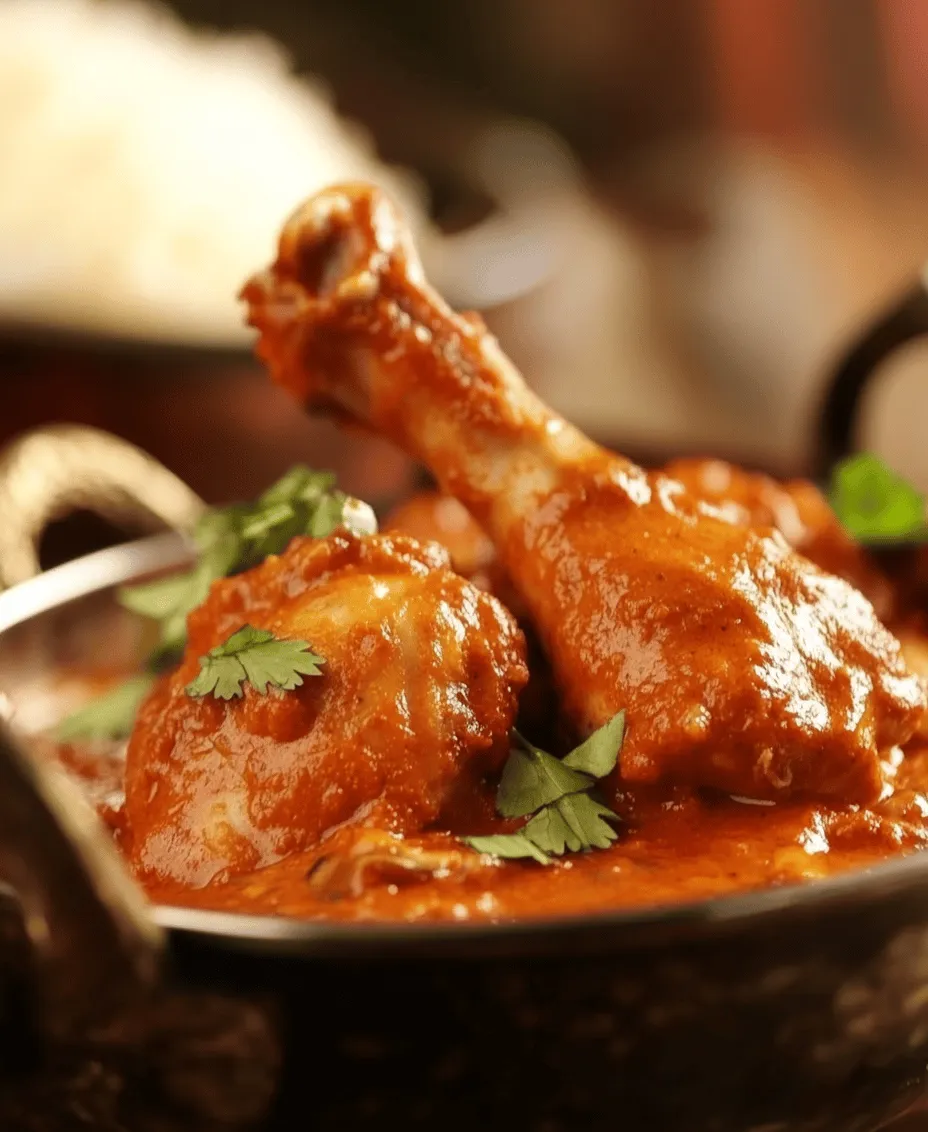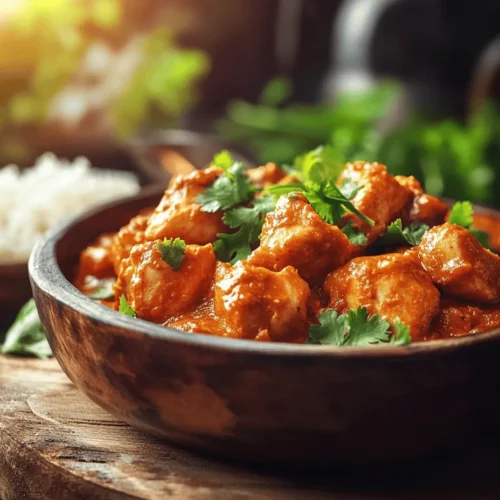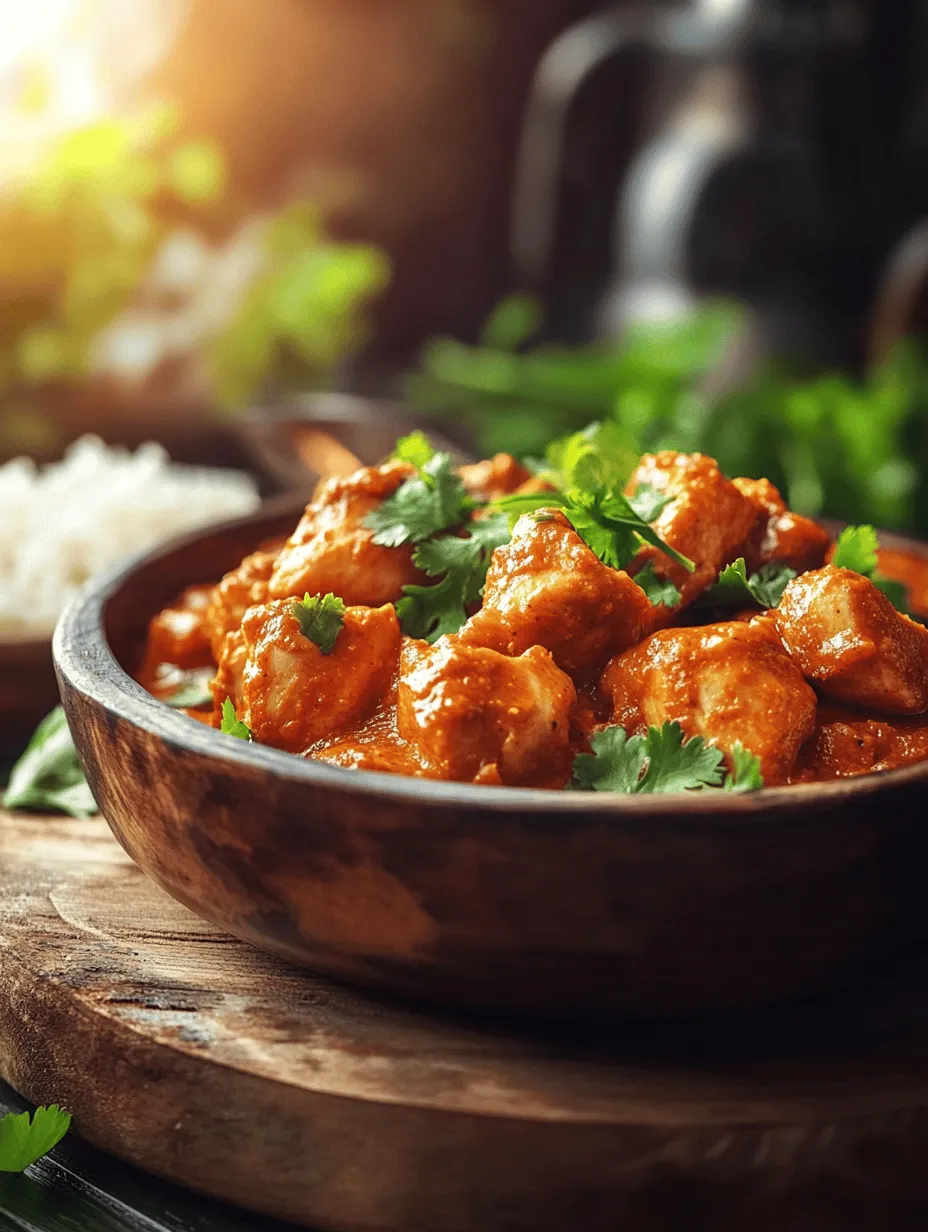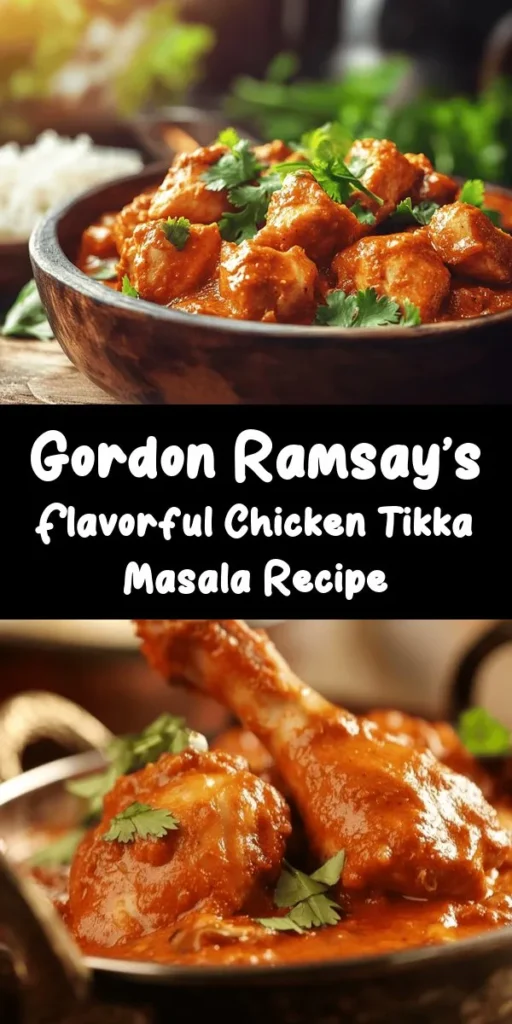Introduction
Chicken Tikka Masala has transcended its Indian roots to become a beloved dish around the world, especially in the United Kingdom, where it has been dubbed a national favorite. This vibrant dish, featuring marinated chicken pieces cooked in a creamy tomato sauce, is a tantalizing blend of flavors and textures that appeals to a wide range of palates. Its popularity can be attributed to its deliciousness and the warmth it brings to the dining table, making it a go-to for family dinners, special gatherings, and even casual weeknight meals.
Renowned chef Gordon Ramsay offers a unique take on Chicken Tikka Masala, infusing his culinary expertise and signature style into this classic recipe. Ramsay’s version emphasizes the importance of mastering the marinade and sauce, ensuring that every component is crafted with care to achieve authentic and rich flavors. By following his method, home cooks can elevate this dish from a simple recipe to a gourmet experience.
Understanding Chicken Tikka Masala
History and Origins of Chicken Tikka Masala
The origins of Chicken Tikka Masala are a subject of culinary debate, with various stories tracing its roots back to the Indian subcontinent. It’s believed that the dish was first created in the 1960s when South Asian chefs in the UK began to adapt traditional recipes to suit British tastes. The blend of marinated chicken, rich spices, and creamy sauce quickly gained popularity, leading to its status as a staple in Indian restaurants across the UK.
The dish embodies a fusion of Indian and British culinary traditions, showcasing how cultural exchanges can create something new and delightful. While the exact birthplace of Chicken Tikka Masala may remain unclear, its evolution reflects the adaptability of Indian cuisine and its ability to resonate with diverse audiences.
The Dish’s Evolution and Its Role in Indian Cuisine and Beyond
Initially, Chicken Tikka was meant to be a simple dish served as part of a larger Indian meal. However, the addition of a rich, spiced tomato sauce transformed it into Chicken Tikka Masala, elevating it to a main course that could stand on its own. This evolution illustrates the versatility of Indian flavors and cooking techniques, allowing chefs to innovate while honoring traditional practices.
Today, Chicken Tikka Masala is not just a dish found in Indian restaurants; it’s a global phenomenon. From casual eateries to high-end dining establishments, chefs worldwide have embraced the dish, often adding their unique twists. This adaptability showcases the dish’s universal appeal, as it can be adjusted to suit varying tastes, dietary preferences, and cultural contexts.
Key Flavor Components That Define Chicken Tikka Masala
At the heart of Chicken Tikka Masala are its bold flavors, which come from a harmonious blend of spices, aromatics, and creamy ingredients. Essential spices typically include garam masala, cumin, coriander, and turmeric, which provide depth and warmth. When marinated in yogurt, these spices not only infuse the chicken with flavor but also tenderize it, ensuring a succulent bite.
The sauce is equally important, made from a base of sautéed onions, tomatoes, and cream. The onions add sweetness and body, while the tomatoes contribute acidity and brightness. Cream introduces a luscious texture, balancing the spices and creating a rich sauce that clings to the chicken beautifully. Together, these elements create the signature taste profile that makes Chicken Tikka Masala so irresistible.
Ingredients Breakdown
Overview of the Essential Ingredients for the Marinade
To achieve the authentic flavors of Gordon Ramsay’s Chicken Tikka Masala, a well-crafted marinade is essential. The primary ingredients include:
– Chicken: Boneless chicken thighs or breasts, cut into bite-sized pieces. Thighs are preferred for their juiciness, but breasts can also be used.
– Yogurt: Plain, unsweetened yogurt acts as the base for the marinade. It not only adds creaminess but also helps tenderize the chicken.
– Spices: A combination of garam masala, cumin, coriander, turmeric, and paprika for color and flavor.
– Ginger and Garlic: Fresh ginger and garlic paste enhance the aromatic profile, contributing to the dish’s depth.
Importance of Yogurt and Spices in Flavor Development
Yogurt is a key player in the marinade, providing a tangy flavor and acting as a tenderizer due to its acidity. The longer the chicken marinates, the more it absorbs the flavors and becomes tender. The spices not only add complexity but also create a beautiful color, transforming the chicken into a vibrant dish when cooked.
Detailed Explanation of the Sauce Ingredients
The sauce for Chicken Tikka Masala is equally important and consists of the following key ingredients:
– Onions: Finely chopped and caramelized to bring out their sweetness.
– Tomatoes: Fresh or canned tomatoes, blended into a puree, provide acidity and body to the sauce.
– Cream: Heavy cream adds richness and balances the spices, creating a smooth, luxurious texture.
– Fresh Cilantro: Chopped cilantro is used as a garnish, adding a fresh element that brightens the dish.
Role of Onions, Tomatoes, and Cream in Creating the Dish’s Signature Texture and Taste
Onions are the backbone of the sauce, providing a sweet and savory base that enhances the overall flavor. When sautéed to perfection, they contribute to the sauce’s depth. Tomatoes add tanginess and acidity, which counterbalances the richness of the cream. Lastly, the cream not only enriches the sauce but also helps mellow out the spices, creating a harmonious blend that coats the chicken beautifully.
Discussion on Ingredient Substitutions for Dietary Preferences
For those with dietary restrictions or preferences, there are several substitutions that can be made without sacrificing flavor:
– Chicken: Tofu, paneer, or chickpeas can be used for a vegetarian or vegan option.
– Yogurt: Non-dairy yogurt can replace traditional yogurt for lactose-free or vegan diets.
– Cream: Coconut milk or cashew cream can be used as a dairy-free alternative to achieve a similarly rich texture.
By making these adjustments, anyone can enjoy a version of Chicken Tikka Masala that meets their dietary needs while still being delicious.
The Marinade: Building Flavor
Step-by-Step Guide to Preparing the Marinade
1. Combine Ingredients: In a large mixing bowl, combine the plain yogurt, garlic and ginger paste, and the spices—garam masala, cumin, coriander, turmeric, and paprika. Mix well until a smooth paste forms.
2. Add Chicken: Cut the chicken into bite-sized pieces and add it to the marinade. Ensure each piece is well-coated with the mixture.
3. Marinate: Cover the bowl with plastic wrap and refrigerate for at least 1 hour, or ideally, overnight. The longer the chicken marinates, the more flavor it will absorb.
Importance of Marination Time for Tenderizing Chicken and Enhancing Flavors
Marination is a crucial step in developing the dish’s flavors and ensuring the chicken remains tender during cooking. The yogurt in the marinade breaks down the proteins in the chicken, resulting in a juicy and flavorful end product. Allowing the chicken to marinate overnight is recommended because it allows the spices to permeate deeper into the meat, leading to a more flavorful experience.
Tips for Selecting the Right Chicken Cuts for Marination
When selecting chicken for Chicken Tikka Masala, opt for thighs over breasts for a more succulent result. Chicken thighs contain more fat, which helps keep the meat moist during cooking. If you prefer using chicken breasts, consider marinating for a shorter time or adjusting the cooking time to prevent them from drying out.
Insights on the Balance of Spices in the Marinade
Achieving the right balance of spices is key to a successful Chicken Tikka Masala. Each spice contributes its unique flavor, and together they create a complex aromatic profile. Start with a base of garam masala and adjust according to your taste preferences. If you prefer a milder flavor, reduce the amount of chili powder or paprika, while those who enjoy a spicier kick can increase the heat.
Cooking the Chicken: Techniques for Perfection
Best Practices for Grilling or Pan-Searing Chicken
Once the chicken has marinated, it’s time to cook it to perfection. There are two popular methods: grilling and pan-searing.
– Grilling: Preheat your grill to medium-high heat. Thread the marinated chicken pieces onto skewers, ensuring they are spaced evenly. Grill for about 10-12 minutes, turning occasionally until fully cooked and charred in spots. The smoky flavor from grilling adds another layer of depth to the dish.
– Pan-Searing: If you don’t have access to a grill, pan-searing is an excellent alternative. Heat a large skillet or frying pan over medium-high heat with a little oil. Add the marinated chicken in batches, ensuring not to overcrowd the pan. Cook for about 6-8 minutes, flipping halfway, until the chicken is golden brown and cooked through.
Importance of Cooking in Batches to Avoid Overcrowding
When cooking the chicken, it is crucial to avoid overcrowding the pan or grill. Cooking in batches allows for even heat distribution, ensuring that the chicken develops a nice char and does not steam. If the chicken is overcrowded, it will release moisture and result in a less desirable texture. Always prioritize quality over quantity when cooking, and give each piece the space it needs to become beautifully cooked.
By following these initial steps and understanding the fundamentals behind Gordon Ramsay’s Chicken Tikka Masala, you’re well on your way to creating a dish that embodies bold flavors and authentic Indian cuisine. Stay tuned for the next part, where we will explore the details of crafting the rich sauce and bringing this iconic dish together.

Visual Cues for Determining Doneness and Achieving a Golden-Brown Crust
When preparing Gordon Ramsay’s Chicken Tikka Masala, achieving the perfect doneness of the chicken is crucial to the dish’s success. Look for a golden-brown crust on the chicken pieces, which not only enhances the visual appeal but also contributes to the overall flavor profile. The chicken should be cooked until it reaches an internal temperature of 165°F (74°C). You can check this using a meat thermometer inserted into the thickest part of the chicken, avoiding bones.
To achieve that coveted crust, you must ensure that your cooking surface is adequately hot before adding the chicken. Searing the chicken in a hot pan allows it to caramelize, creating a depth of flavor. If your chicken releases too much moisture while cooking, it can steam instead of sear, preventing that beautiful crust. To avoid this, cook in batches if necessary, allowing enough space between the pieces.
How to Retain Moisture and Tenderness in the Chicken
To keep your chicken moist and tender throughout the cooking process, marinating is key. The marinade not only infuses flavor but also helps break down the proteins in the chicken, resulting in a juicier final product. Ensure that you marinate the chicken for at least one hour, or preferably overnight in the refrigerator, to maximize flavor absorption.
Another technique for retaining moisture is to avoid overcooking the chicken. Once the chicken is browned and reaches the desired internal temperature, remove it from the heat immediately. It will continue to cook slightly from residual heat, so err on the side of caution. Additionally, incorporating it into the sauce early on will keep it moist, as it will absorb flavors while simmering.
Creating the Sauce: The Heart of the Dish
The sauce is the heart and soul of Chicken Tikka Masala. Here’s how to create a rich, flavorful sauce that complements your perfectly cooked chicken.
Detailed Instructions on Preparing the Sauce
1. Sauté Onions for Flavor Depth: Begin by heating a generous amount of oil or ghee in a large skillet over medium heat. Add finely chopped onions and sauté them until they become translucent and golden brown. This process typically takes about 10 minutes. The caramelization of the onions adds a sweet and savory depth to the sauce that forms its base.
2. Incorporate Garlic and Ginger: Once the onions are golden, add minced garlic and ginger. Sauté for an additional 1-2 minutes until fragrant, being careful not to let them burn.
3. The Role of Spices in the Sauce: Next, it’s time to add the spices. Incorporate garam masala, ground cumin, coriander, turmeric, and red chili powder. Toasting these spices for a minute in the hot oil will release their essential oils and enhance their flavors. Adjust the heat level by varying the amount of red chili powder according to your preference.
4. Blending Crushed Tomatoes into a Smooth, Rich Sauce: Once the spices are aromatic, add crushed tomatoes to the pan. Stir well to combine, and let the mixture simmer for 5-10 minutes until it thickens slightly. For an even smoother sauce, use an immersion blender or transfer the mixture to a blender and pulse until smooth before returning it to the heat.
5. Achieving the Perfect Creamy Consistency with Heavy Cream: To finish the sauce, reduce the heat to low and stir in heavy cream. This step is crucial for achieving the signature creamy texture of Chicken Tikka Masala. Allow the sauce to simmer gently for another 10 minutes, which helps meld the flavors together.
Combining the Elements: Bringing It All Together
Now that your chicken is cooked and your sauce is prepared, it’s time to bring everything together.
1. Integrating Cooked Chicken into the Sauce: Add the cooked chicken pieces into the simmering sauce. Stir gently to coat the chicken thoroughly with the sauce, ensuring each piece is enveloped in the rich flavors.
2. Importance of Simmering for Flavor Melding: Let the chicken simmer in the sauce for at least 10 minutes. This step allows the chicken to absorb additional flavors from the sauce, enhancing the overall taste of the dish.
3. Adjusting Seasoning to Taste for a Balanced Dish: Before serving, taste the sauce and adjust the seasoning as necessary. You may want to add salt, sugar, or more spices depending on your preference. A pinch of sugar can balance the acidity of the tomatoes, while a little salt can elevate the flavors.
Garnishing and Serving Suggestions
The presentation of your Chicken Tikka Masala can enhance the dining experience. Here are some garnishing and serving ideas:
1. Ideas for Garnishing with Fresh Coriander: Fresh coriander (cilantro) adds a burst of color and freshness. Finely chop it and sprinkle generously over the dish just before serving. For an extra touch, you can also add thinly sliced chili peppers or a drizzle of cream.
2. Recommended Accompaniments: Chicken Tikka Masala pairs wonderfully with basmati rice, which absorbs the savory sauce beautifully. Warm naan bread is perfect for scooping up the sauce, making it an essential addition to your meal. Consider serving a side of raita (yogurt sauce) to cool the palate, especially if you have adjusted the spice levels.
3. Presentation Tips for an Inviting Dining Experience: To create an inviting table setting, serve the Chicken Tikka Masala in a beautiful dish, perhaps a traditional Indian curry pot. Accompany it with a colorful array of sides, such as a cucumber salad, roasted vegetables, or lentils, to provide a well-rounded meal.
Nutritional Information
Understanding the nutritional profile of Chicken Tikka Masala can help you enjoy it mindfully.
1. Overview of the Nutritional Profile: A typical serving of Chicken Tikka Masala contains approximately 350-450 calories, depending on the portion size and ingredients used. It provides a good source of protein from the chicken and essential vitamins from the spices and tomatoes.
2. Discussion on Portion Sizes and Caloric Content: Standard serving sizes can vary, but a portion of about one cup of Chicken Tikka Masala paired with a half-cup of basmati rice is generally sufficient for a satisfying meal.
3. Healthier Cooking Tips Without Sacrificing Flavor: To make a lighter version of this dish, consider using yogurt instead of heavy cream, or experiment with coconut milk for a dairy-free option. Reducing the amount of oil and serving with more vegetables can also enhance the nutritional content without sacrificing flavor.
Conclusion
Gordon Ramsay’s Chicken Tikka Masala is a delightful dish that brings together the vibrant spices and creamy textures of Indian cuisine. From marinating the chicken for optimal flavor to creating a rich, aromatic sauce, each step is critical in delivering the authentic taste of this beloved meal.
By following the detailed instructions and tips provided, you can recreate this dish in the comfort of your home and share it with family and friends. The joy of cooking lies in the experience itself and the satisfaction of serving a meal made with love. So gather your ingredients, follow the steps, and enjoy the process of crafting this delightful Chicken Tikka Masala. Whether it’s for a special occasion or a weeknight dinner, this dish is sure to impress and satisfy your taste buds.



